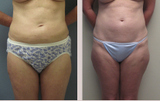Over time, some women need to have adjustments made to their breasts after their augmentation procedure.
On occasion a saline-filled implant may leak and deflate. This can be treated with simply an implant exchange procedure. In some instances, women may need to have silicone implants removed and replaced.
For the rare patient that develops severe scar tissue around their implants, the scar tissue can be removed and the implants replaced. Other issues, such as unsatisfactory implant position or size, can often be improved with revisional surgery.
In most cases, the corrective procedure can be performed through the old small scar created from your original augmentation procedure. If you have had breast augmentation, but now have problems or don't like your look, then a revisionary procedure may be the solution to give you the look you desire.
When a breast implant is placed, the body attempts to wall it off forming a capsule around the implant. This capsule can be present within a week after surgery and is eventually present in all breasts containing implants.
The capsule can be of variable thickness and have different properties from patient to patient. Thicker capsules or those that contain muscle cells can contract and deform the breast and in some cases also cause painful capsule contracture.
It is not known exactly why some capsules become more problematic cosmetically speaking than others. It is thought that blood around the implant at the time of surgery or low grade infection early or late after surgery in is the culprit.
Some capsules cause problems early after surgery and some take years to transform into a problematic capsule. In all cases of problematic capsules the naturally round contour of the breast is flattened in one or more areas including the upper portions of the breast. This can also occur if a breast implant breaks or ruptures.
Prior to the 1990s this was treated by squeezing the breasts hard enough to break the capsule - closed capsulotomy. This resulted in high recurrence rates because the capsule was not removed and implant rupture rates were very high.

